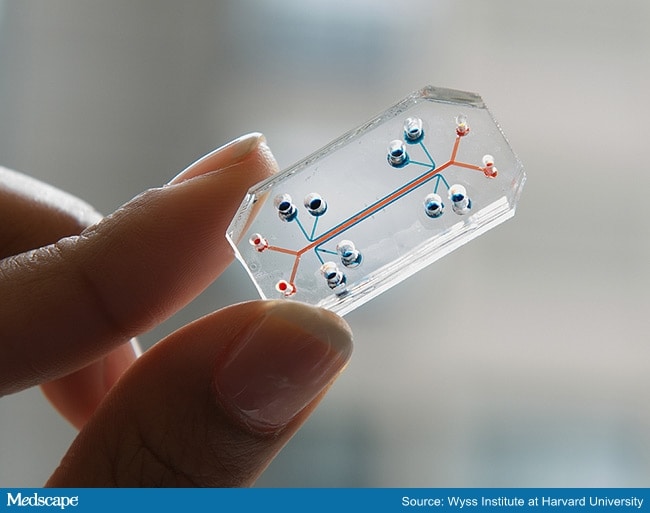[Updated] In a laboratory at Harvard University, there is a small plastic chip that can breathe like a human lung. There are also chips that function like mini hearts, livers, kidneys, and intestines. And just last week, Harvard researchers announced that they’ve developed a chip that mimics the pathology of muscular dystrophy, a contraption that could help doctors develop desperately needed treatments for the condition.
These bodily mimics are being developed at Harvard's Wyss Institute for Biologically Inspired Engineering, a research center dedicated to developing cutting-edge healthcare technologies inspired by—as the name suggests—human biology.
By designing so-called "organs-on-chips," Wyss researchers hope to provide a more efficient, less costly way to run drug trials. If the approach pans out, the technology could also minimize the pharmaceutical industry's reliance on animal testing, and one day help personalize drug therapies for an array of conditions.
Breathing on a Chip
In 2010, Wyss founding director Dr Donald Ingber and his colleagues published a paper in Science[1] reporting on their lung on a chip (Figure 1), one of the field's more striking conceptions to date.
The "organ" is about the size of a computer memory stick and contains a central channel divided by a porous membrane, one side of which is lined with with living human lung cells and the other with endothelial cells (those that line our blood vessels). By passing air over the lung tissue and a blood cell-containing medium beneath the "vasculature"—and by applying suction to two side channels to mimic breathing mechanics—normal lung function, including alveolar oxygen exchange, can be simulated.
Not only that, Ingber's group has used the chip to successfully model both pulmonary infection and edema (Video 1), as well as drug toxicities and the injurious effects of airborne particulates.

Figure 1. Lung on a chip. Courtesy of Wyss Institute at Harvard University
Although chip organ research has been around for years, only recently have researchers started to seed the devices with multiple cell types and incorporate physiologic factors, such as breathing, in order to better mirror human physiology. Ingber and many other researchers feel that chip organ technology might not only help scientists better understand disease etiology and organ physiology, but also allow cheaper, more efficient pharmaceutical, chemical, and cosmetic testing.
"Right now, preclinical drug development is carried out in animal models," explains Ingber. "But many of these models are terrible. They're not testing a drug on actual human cells, and in many cases drugs that don't show toxicity in animals eventually do in humans."
Ingber feels that by testing drugs on chips rather than animals, drug developers could get earlier insights into a compound's mechanism of action and its potential toxicity, thereby allowing them to better select which drugs are worth the time and money of further research.
Ingber's group has now honed their lung-on-a-chip to to model both asthma and pulmonary edema. He and his Wyss colleagues have also developed over 10 other chip organs[2,3]—including chip intestines, kidneys, livers, bone marrow, and blood/brain barriers—and have commercialized the technology through a Boston-based company called Emulate, for which Ingber serves as chair of the Scientific Advisory Board. They've already announced partnerships with multiple pharmaceutical companies.
Berkeley bioengineering professor Dr Kevin E. Healy concurs with Ingber. Healy is one of several researchers involved the National Institutes of Health's organ-on-chip initiative. "Often, drugs fail in phase 1 or 2 studies after lots of time and money have been invested," he explains. "I think chip technology will help us better predict these failures."
Healy also jokingly cites what those in the drug development field call "Eroom's law"—the observation that drug development has gradually gotten slower and more expensive over the years (it's a tongue-in-cheek reversal of Moore's law, which states that on average, computer processing power doubles every 2 years). His hope is that chip technology will help turn around drug development's sluggish reputation, and his group is already testing drugs that were pulled for being too toxic in animal or human studies. Perhaps chip organs could have red-flagged the compounds earlier on.

Video 1. Chip organ modeling pulmonary function and infection. Courtesy of Wyss Institute at Harvard University
Medscape Family Medicine © 2016 WebMD, LLC
Any views expressed above are the author's own and do not necessarily reflect the views of WebMD or Medscape.
Cite this: Will Organs on Chips Revolutionize Drug Trials? - Medscape - Jun 17, 2016.





Comments